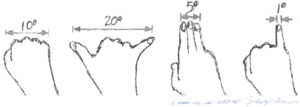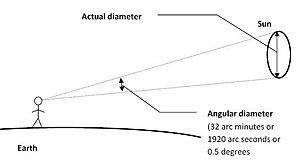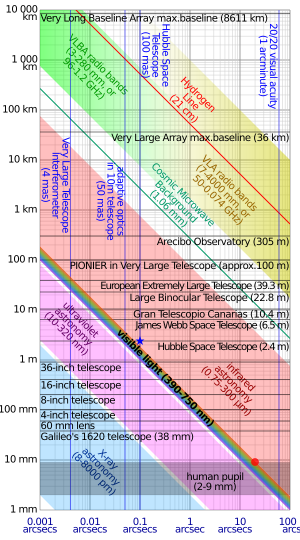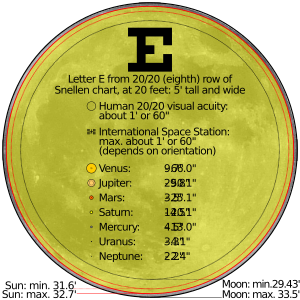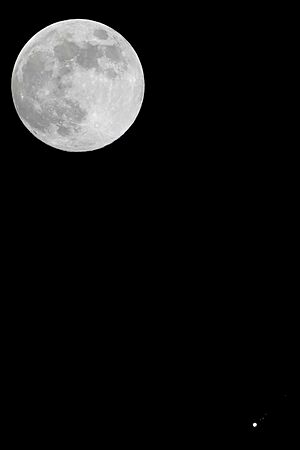Angular diameter facts for kids
The angular diameter (also called angular size or apparent size) describes how big an object looks from a certain distance. Imagine holding a coin far away. It looks tiny! But if you hold it close to your eye, it looks much bigger. The angular diameter is the angle that object takes up in your vision.
For example, when you look at the Moon or the Sun, they both look about the same size in the sky. This is because they have a similar angular diameter, even though the Sun is much, much bigger than the Moon in real life. The Sun is also much farther away.
Your eyes can usually see objects that have an angular diameter of about 1 arcminute. This is a very small angle, like seeing a 30-centimeter (about 1 foot) object from 1 kilometer (about half a mile) away.
Contents
How to Calculate Angular Diameter
You can figure out the angular diameter of a round object if you know its real size and how far away it is.
Imagine you have a flat circle. If you look at it straight on, its angular diameter can be found using a special math formula. If the object is a sphere (like a ball), the formula is slightly different because the edges you see are a bit closer to you than the center of the sphere.
But for most things in space, which are very far away, the difference between these two formulas is tiny. We can use a simpler idea: the angular diameter is roughly the object's real size divided by its distance.
Estimating Angular Diameter with Your Hand
You can get a rough idea of angular sizes by holding your hand out at arm's length.
- Your fist, held at arm's length, covers about 10 degrees.
- Your pinky finger, held at arm's length, covers about 1 degree.
- Your spread-out hand (thumb to pinky) covers about 20 degrees.
This can be a fun way to estimate how big things look in the sky!
Angular Diameter in Space
In astronomy, scientists often talk about the angular diameter of celestial objects (like planets and stars) as seen from Earth. This is because it's easier to measure how big something looks than to figure out its exact real size and distance.
Since objects in space are so far away, their angular diameters are usually very small. So, astronomers use tiny units to measure them:
- A degree (°) is a full circle divided into 360 parts.
- An arc-minute (′) is 1/60th of a degree.
- An arc-second () is 1/60th of an arc-minute (or 1/3600th of a degree!).
To give you an idea:
- The full Moon looks about 0.5 degrees wide, which is 30 arc-minutes, or 1800 arc-seconds.
- If you drew a line 1 mile (1.6 km) long on the Moon, it would look like it's about 1 arc-second long from Earth!
Here are some examples of objects that have an angular diameter of 1 arc-second:
- A 1-centimeter object (like a small button) from 2.06 kilometers away.
- A 725-kilometer object (like a small moon) from 1 astronomical unit (AU) away. (1 AU is the distance from Earth to the Sun).
The Sun and the Moon have very similar angular diameters when seen from Earth. This is why we can have amazing solar eclipses, where the Moon perfectly blocks out the Sun!
Even though Pluto is physically bigger than Ceres, Ceres looks much bigger from Earth because it's closer to us.
Angular Sizes of Space Objects
This table shows how big some famous space objects look from Earth:
| Celestial object | Angular diameter or size | Notes |
|---|---|---|
| Magellanic Stream | over 100° | |
| Gum Nebula | 36° | |
| Milky Way | 30° (by 360°) | This is our home galaxy! |
| Width of spread out hand with arm streched out | 20° | |
| Serpens-Aquila Rift | 20° by 10° | |
| Large Magellanic Cloud | 10.75° by 9.17° | The brightest galaxy you can see without a telescope, besides our own Milky Way. |
| Width of fist with arm streched out | 10° | |
| Small Magellanic Cloud | 5°20′ by 3°5′ | |
| Andromeda Galaxy | 3°10′ by 1° | Looks about six times wider than the Sun or Moon. You can only see its small, bright center without long-exposure photos. |
| In the Moon's sky the apparent size of Earth | 2° - 1°48′ | Earth looks about three to four times bigger from the Moon than the Moon looks from Earth. |
| Orion Nebula | 1°5′ by 1° | |
| Width of little finger with arm streched out | 1° | |
| Moon | 34′6 – 29′20 | The Moon's diameter is 3,474 km. |
| Sun | 32′32 – 31′27 | The Sun's diameter is 1,391,400 km. |
| International Space Station (ISS) | 1′3 | The ISS is about 108 meters wide. |
| Maximum resolvable diameter by the human eye | 1′ | This is like seeing a 0.3-meter object from 1 kilometer away. |
| About 100 km on the surface of the Moon | 1′ | This is like seeing a large crater on the Moon. |
| Jupiter | 50.1 – 29.8 | |
| Mars | 25.1 – 3.5 | |
| Saturn | 20.1 – 14.5 | |
| Mercury | 13.0 – 4.5 | |
| Uranus | 4.1 – 3.3 | |
| Neptune | 2.4 – 2.2 | |
| Ganymede | 1.8 – 1.2 | Ganymede has a diameter of 5,268 km. |
| An astronaut (~1.7 m) at a distance of 350 km (average ISS altitude) | 1 | |
| Ceres | 0.84 – 0.33 | |
| Pluto | 0.11 – 0.06 | |
| R Doradus | 0.062 – 0.052 | This star is thought to look the biggest from Earth, even though it's far away. |
| Betelgeuse | 0.060 – 0.049 | |
| Event horizon of black hole M87* at center of the M87 galaxy, imaged by the Event Horizon Telescope in 2019. | 0.000025 | This is like seeing a tennis ball on the Moon! |
The Sun looks about the same size as the Moon in our sky. This is because the Sun is about 400 times bigger than the Moon, but it's also about 400 times farther away!
Non-Circular Objects in Space
Many objects in deep space, like galaxies and nebulae, are not perfectly round. So, astronomers often give two measurements for their angular size: a "major axis" (the longest part) and a "minor axis" (the shortest part). For example, the Small Magellanic Cloud looks about 5 degrees by 3 degrees.
Defect of Illumination
Sometimes, when we look at a planet or moon, only part of it is lit up by the Sun. The "defect of illumination" is the angular width of the part that is not lit. For example, if a planet is 40 arc-seconds wide but only 75% lit, then the unlit part is 10 arc-seconds wide.
See also
 In Spanish: Diámetro angular para niños
In Spanish: Diámetro angular para niños
- Angular resolution
- Solid angle
- Visual acuity
- Visual angle



